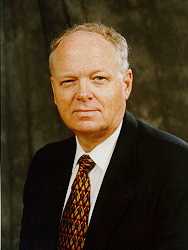|
Conducting
Clarity through the "Box Technique!" For more information about Dr. Anderson, visit his faculty web site. Or you may contact him via email. |
Conducting is sometimes described as a system of communication through gestures. Like any other type of communication, being very clear about your intentions is the best way to insure that what is communicated is what was intended.
A simple concept for helping you convey your intentions clearly to your musical group is to use what I call the "Box Technique." Simply put, it asks that you conceptualize a series of at least four boxes, beginning with a very small box and three increasingly larger boxes around it. See the illustration below:

In the smallest box, conducting gestures involve only the index finger. In the next biggest box, only the hand from the wrist moves. In the third biggest box, movement occurs basically in the hand and forearm (limiting much of the upper arm movement). And in the biggest box, the whole arm (wrist, fingers and all!) is involved.
|
Watch a short video! |
|
|
Video #1 - The Box Technique |
- 256K - broadband connection | 56K - dial-up connection |
If you use a baton, the principles are the same. See a demonstration.
|
Watch a short video! |
|
|
Video #2 - Baton |
- 256K - broadband connection | 56K - dial-up connection |
You should practice various conducting patterns in each of the box sizes until they feel very comfortable to you.
Using a regular 4 pattern, let's see how the technique can be used to bring in (or cue) a section of your choir or instrumental ensemble when some music is already ongoing (in other words, cueing an entrance).
The key concept here is "contrast." To make your cueing gesture very clear to the group, it needs to stand out from the conducting gestures just before it. Thus, if you were conducting in the third biggest box, one beat or two before you intend to make the "preparation" gesture for the cue you are going to give, you reduce the size of your gesture to at least one box smaller in size (at times drastically reducing the arm and wrist movement so that the beat pattern almost seems to come to a complete stop). Then the "rebound" of the preparation gesture for the cue should increase back to the regular size or even to a larger box for that cue. If you do it correctly, the preparation gesture will "jump out" at the performers, making it very clear that you are intending someone or some group to enter at that time. Let's see two demonstrations of this.
|
Watch a short video! |
|
|
Video #3 - Contrast |
- 256K - broadband connection | 56K - dial-up connection |
| Video #4 - Box Technique in Practice | - 256K - broadband connection | 56K - dial-up connection |
It is easiest for most conductors to make this gesture when setting up a preparation on beat 4 for an entrance on beat 1. The technique will work on any beat, however, but the other beats will require a little more practice. A good exercise to practice this is to set up a sequence in which you change the preparation (cue) in succeeding measures to one beat later each time. Thus, in the first measure, the preparation is on beat 4 (for an entrance on beat 1). In the second measure, the preparation is on beat 1 (for an entrance on beat 2), etc. View an example of this exercise now.
|
Watch a short video! |
|
|
Video #5 - Box Technique on Other than Beat One |
- 256K - broadband connection | 56K - dial-up connection |
You can use the same "Box Technique" for release gestures (though one may well find that using the left hand for releases is easier than using the pattern hand).
|
Watch a short video! |
|
|
Video #6 - Releases |
- 256K - broadband connection | 56K - dial-up connection |
Even when using the left hand, the concept of the Box Technique should be used. This, then, still involves "contrast." For conductors wise enough to save using the left hand to help with cueing, expression, and releases, just bringing the left hand into the sight lines of your group suggests that something important is going to happen! When you add a clear preparation for the cues or releases (contrasting a clear preparation gesture with the almost stationary position of the left hand just before the preparation) it is hard to miss the intended communication. Let's see some examples.
|
Watch a short video! |
|
|
Video #7 - Use of left hand for Releases and Cues |
- 256K - broadband connection | 56K - dial-up connection |
Don't be discouraged if you can't master each of these gestures immediately. Nevertheless, practice them faithfully and you will quickly find they can become second nature to you. Then you will have succeeded in improving an important element of your effectiveness as a conductor.
| If you would like to be added to the TSMP Email Mailing List and receive periodic notifications of new articles and updates to this website, then please email TSMP.
The Texas School Music
Project is a source for ideas and information
concerning pedagogical
practices in the music classroom or rehearsal hall. The TSMP is a service provided to
all music specialists by the faculty
of
the Department of Music
at Stephen F. Austin State University. Copyright ? 2002, Department of Music at Stephen F. Austin State University |
